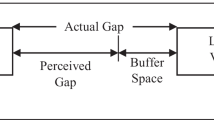Abstract
The current study investigates the way in which the saturation flow of a traffic lane is representedthrough widely used cellular automata models. In particular, following a literature search specific cellular automata models that have been developed to simulate mainly urban traffic are selected for this study. The values of the saturation flow as these are produced via model simulations with the modification of relevant model parameters including maximum desired speed and probability are defined through appropriate statistical values.
Access this chapter
Tax calculation will be finalised at checkout
Purchases are for personal use only
Preview
Unable to display preview. Download preview PDF.
Similar content being viewed by others
References
Nagel, K., Schreckenberg, M.: A cellular automaton model for freeway traffic. J. Phys. I 2, 2221–2229 (1992)
Spyropoulou, I.: Modelling a signal controlled traffic stream using cellular automata. Transp. Res. C 15(3), 175–190 (2007)
Barlovic, R., Santen, L., Schadschneider, A., Schreckenberg, M.: Metastable states in cellular automata. Eur. Phys. J. B 5(3), 793–800 (1998)
Brilon, W., Wu, N.: Evaluation of Cellular automaton for Traffic Flow Simulation on Freeway and Urban Streets. In: Brilon, W., Huber, F., Schreckenberg, M., Wallentowitz, H. (eds.) Traffic and Mobility, pp. 163–180. Springer, Berlin (1999)
Chopard, B., Luthi, P.O., Queloz, P.A.: Cellular automat model of car traffic in two-dimensional street networks. J. Phys. A 29, 2325–2336 (1996)
Esser, J., Schreckenberg, M.: Microscopic simulation of urban traffic based cellular automata. Int. J. Modern Phys. C 8(5), 1025–1036 (1997)
Chowdhury, D., Schadschneider, A.: Self-organization fo traffic jams in cities: Effects of stochastic dynamics and signal periods. Phys. Rev. E 59(2), 1311–1314 (1999)
Ruskin, H.J., Wang, R.: Modelling Traffic Flow at an Urban Unsignalised Intersection. In: Sloot, P.M.A., Tan, C.J.K., Dongarra, J., Hoekstra, A.G. (eds.) ICCS-ComputSci 2002, Part I. LNCS, vol. 2329, pp. 381–390. Springer, Heidelberg (2002)
Wu, Q.-S., Li, X.-B., Hu, M.-B., Jiang, R.: Study of traffic flow at an unsignalized T-shaped intersection by cellular automata model. Eur. Phys. J. B 48, 265–269 (2005)
Jiang, R., Wu, Q.-S.: A stopped time dependent randomization cellular automata model for traffic flow controlled by traffic light. Phys. A 364, 493–496 (2006)
Płaczek, B.: Fuzzy Cellular Model for On-Line Traffic Simulation. In: Wyrzykowski, R., Dongarra, J., Karczewski, K., Wasniewski, J. (eds.) PPAM 2009, Part II. LNCS, vol. 6068, pp. 553–560. Springer, Heidelberg (2010)
He, H.D., Lu, W.Z., Dong, L.Y.: An improved cellular automaton model considering the effect of traffic lights and driving behaviour. Chin. Phys. B 20(4), 040514-1–040514-7 (2011)
Kimber, R.M., McDonald, M., Hounsell, N.: Passenger car units in saturation flows: concept, definition, derivation. Transportation Research 19B(1), 39–61 (1985)
Transportation Research Board: Highway Capacity Manual. Special Report 209. National Research Council, Washington D.C. (2000)
Akcelik, R.: Traffic signals: Capacity and timing analysis. Australian Road Research Board Research Report, APR 123. Australian Road Research Board, Hawthorne (1981)
Road Research Laboratory: A method of measuring saturation flow at traffic signals. Road Note 34, Department of the Environment. Road Reasearch Laboratory, Harmondsworth (1963)
Greenshields, B.D., Shapiro, D., Erickson, E.L.: Traffic performance at urban intersections. Bureau of Highway Traffic, Technical Report, 1. Yale University, New Haven, Conn (1947)
Branston, D., Van Zuylen, H.: The estimation of saturation flow, effective green time and passenger car equivalents at traffic signals by multiple linear regression. Transportation Research 12(1), 47–53 (1978)
Spyropoulou, I.: Modelling a signal controlled traffic stream using cellular automata. Transportation Research Part C 15(3), 175–190 (2007)
Fellendorf, M., Vortisch, P.: Validation of the Microscopic Traffic Flow Model VISSIM in Different Real-World Situations. In: Proceedings of the 80th Annual Meeting of the Transportation Research Board, TRB, Washington D.C. (2001)
Laufer, J.: Freeway capacity, saturation flow and the car following behavioural algorithm of the VISSIM microsimulation software. In: 30th Australasian Transport Research Forum, Melbourne, Australia (2007)
Author information
Authors and Affiliations
Editor information
Editors and Affiliations
Rights and permissions
Copyright information
© 2012 Springer-Verlag Berlin Heidelberg
About this paper
Cite this paper
Spyropoulou, I. (2012). Cellular Automata Model Properties: Representation of Saturation Flow. In: Sirakoulis, G.C., Bandini, S. (eds) Cellular Automata. ACRI 2012. Lecture Notes in Computer Science, vol 7495. Springer, Berlin, Heidelberg. https://doi.org/10.1007/978-3-642-33350-7_85
Download citation
DOI: https://doi.org/10.1007/978-3-642-33350-7_85
Publisher Name: Springer, Berlin, Heidelberg
Print ISBN: 978-3-642-33349-1
Online ISBN: 978-3-642-33350-7
eBook Packages: Computer ScienceComputer Science (R0)



